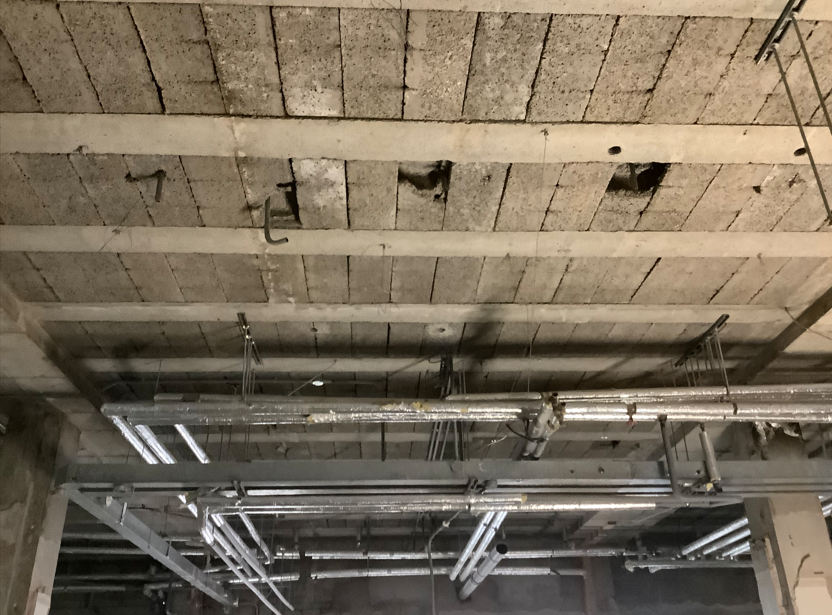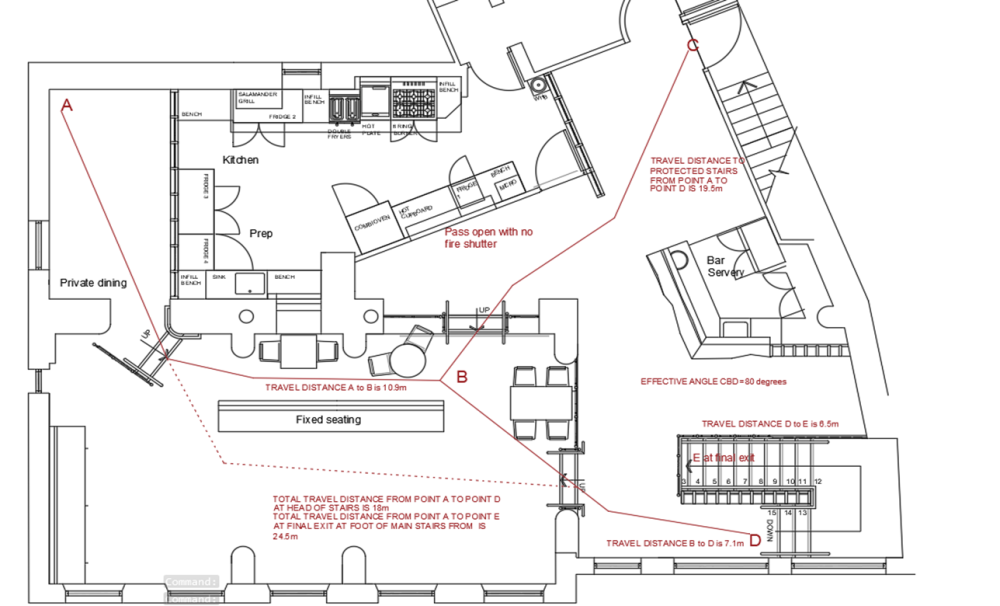
Lyledunn
Power Member-
Posts
102 -
Joined
-
Last visited
Everything posted by Lyledunn
-
Three storey office building. This is looking up at the underside of the first floor. The ground floor is to be a day-time diner. The client wants to leave the slab exposed. I can get it repaired but would not be able to get confirmation of the necessary 60min fire resistance. Anyone dealt with this type of issue before?
-
What do you make of this. It seems claims will not be considered where a breach of fire safety regulations is either confirmed or alleged. Protection for client, designer and contractor (and perhaps fire risk assessor),is no more.
-
Might it have been a simple mistake on original installation? It is common to provide a door and a bit to some offices to allow bulky furniture and other items to be moved in and out. The smaller leaf is retained with shoot bolts without a door closer.
-
It is often done in such premises and probably without significant detriment to fire safety. Where done, I would agree with MN above and also say frames should be secured with mirror plates or similar to prevent them being dislodged. However, it doesn’t seem logical for Building Regulations to require fairly stringent spread of flame characteristics for walls in escape routes only for someone to go plastering them with all sorts of detritus.
-
Fire Risk Assessment required for empty building?
Lyledunn replied to a topic in Fire Risk Assessments
But the retired fire officer had a uniform with shiny buckles, surely that trumps all statutory obligations and industry standard guidance! -
Is there a spread of flame characteristic for float glass? A BC officer has asked for confirmation of same from a professional glazing body. I never considered the matter before as I thought the required SOF classification for any type of glass would be met naturally. The glazing is just a decorative element in a restaurant so no fire resistance required.
-
Irrespective of the control measures needed to meet any minimum requirements in guidance, I think if I was on the resident’s committee, I would be seeking to lobby the stairs at at ground, first and second as well as pushing for the AOV. Sorry to be off piste, my work is mostly in the hospitality sector but even there I would rarely be a slave to a minimum acceptable level of fire safety.
-
You don’t indicate the age of your property. It is very possible that there is some kind of defect in the lining that is causing leakage into your neighbours roof space. The defect can be relatively small and very difficult to detect but can spill smoke and noxious gas that even in small quantities can be harmful and, at the very least, unpleasant. In my youth, I remember the smell of sooty smoke in my bedroom when the neighbour lit their fire. The house was over 100 years old. When a major refurbishment was carried out and access was made into the loft, you could see the little puffs of smoke breaking through the dosed pointing in the brickwork which formed part of the neighbour’s chimney construction. Suggest you engage a professional to fit an appropriate class of liner, and, perhaps, a fan.
-
Consider a typical restaurant premises, would you consider the kitchen to be an ancillary part for the purpose of Building Regulations? Before Anthony jumps down my throat, I did post this on another forum for which I have the upmost regard. However, it has fallen apart over the last few years, which is a pity because it is incredibly beneficial to get the views of other professionals in the industry. I note some cracking good advice on this forum.
-
I don’t know anything about flats, all of my work is in the hospitality industry but one thing I do know is that just because there is a certificate of completion issued by BC, does not guarantee the building is fire safe. One venue constructed after the introduction of the Building Regulations (NI) 2012, has a plethora of relatively serious issues relating to fire spread, mostly hidden away above suspended ceilings. I couldn’t be sure when these issues arose but to base any kind of determination on fire safety strategy solely on when the building was erected would seem imprudent.
-
It is not the ceiling that is required to be fire resistant but the floor as a composite, a subtle but important difference. I often hear builders ask about how many sheets or what thickness of PB is needed to provide a certain fire resistance without understanding the element should be treated as a composite. In purpose group 3 compartmented floors are not required but elements of structure, like floors, are required to be at least 30min REI depending on height. It is not unusual for purpose groups to change in multi-storey office buildings. We are involved in a conversion at the moment where ground and first of a recently constructed office block will become a cocktail bar and restaurant. Careful planning will give building owners better flexibility.
-
Thank you Mike. Actually, although I referred to diagrams in ADB, I was tasked with confirming compliance with Technical Booklet E (TBE), which is the more dated ADB equivalent guidance in Northern Ireland. The works to erect the kitchen were unauthorised and now need to be regularised. My task is to demonstrate that the requirements of TBE have been either met or not, irrespective of the application of any common sense approach. The requirement of 4.2b in ADB is entirely sensible, however, there is no such form of words in TBE. TBE does require at least 30min enclosure of “special fire hazard” but it is easy to demonstrate that a kitchen does not fall into that category by using unambiguous references in the document itself. Whilst I feel a tad uncomfortable with such a pedantic approach, I have cautioned that irrespective of compliance with TBE, there will be other parties such as the insurance company, fire risk assessor, etc who may see the need for appropriately fire rated enclosing walls and/or the provision of automatic extinguishing equipment under the canopy etc.
-
Cheers Mike, many thanks for your reply. My query really only relates to whether the assertion that there are two alternative exits for this room by virtue of interpretation of diagrams 2.1 and 2.2 in ADB is valid. However, I will answer the points you raise; Where is the kitchen extracting to? Straight through exterior wall at rear of kitchen What suppression does the cooking use? None The travel distance of 18m is extremely fortuitous, but what about furniture? Yep, but that is what 10.9m and 7.1m add up to and that is what the measurement tool on Autocad says. If there are two alternative exits, the total allowable travel distance is 45m so furniture allowance would not be an issue. The note about travel distance A to D is next to C, I’d move the note to avoid confusion. Yes indeed, my mistake! Should read A to C The private area could be considered a dead end. Yes, I think it could be but not sure why you see that as an issue To avoid ambiguity, I would draw the effective angle with a leader line and angle dimension. Agreed, good point Are both stairs protected with fire doors? Fire door at point C giving access to a protected stair. The room is open to the other stair but it is appropriately separated from the ground floor and leads directly to the outside via a final exit door at the foot. Is the occupancy the same for both floors Yes.
-
I should have added, are you in agreement with the interpretation?
-
You can see by the travel distances that this is quite a small first-floor restaurant. Two exits to the right hand side of the room. As far as a I can interpret the requirements of diagrams 2.1 and 2.2 of ADB V2, the arrangement is compliant. Point A is the furthest point in the room, C is access to a protected stair and D is the head of a stair that is separated from the ground floor.
-
You can imagine how it would look for a national enterprise if there was a fatality in the living quarters due to a fire in one of their pubs! Irrespective of whether the floor fire resistance was a contributing factor or whether robust control measures were in place to mitigate non-compliance with current building regulations, I can hear the TV journalist with a microphone stuck in their face sensationalising the non-compliance issue! It must indeed be a nightmare to manage a rational fire safety strategy for a plethora of individual circumstances across the separate U.K. nations. I hope I am not telling granny how to suck eggs, but increasing fire resistance of floors can often be easier done from the space above.
-
Are you engaged in major alterations of these pubs rather than assessing existing control measures? Here (NI) full plan applications will inevitably require 60min.
-
Fire exit Sign direction, arrows up or down for final door leading outside?
Lyledunn replied to a topic in Fire Exits
When these pictograms first surfaced, I asked my dear old mum what she thought the sign you have over your door meant. After some perplexed thought, she ventured “gents toilet downstairs”. I come across this all the time as I do hundreds of EL inspections. Whilst there are some who need to straighten their knickers on the pedantic aspects, I have stopped recording it as a deviation unless there is obvious confusion. -
Well, in the professional world I inhabit, that being the hospitality sector, for some eager beavers the number 60 was carted down the mountain by Moses. For others, a more flexible approach might be in order depending on circumstances. However, the feathers can fly when the flexible meets the pedantic!
-
Mike is correct as this is the arbitrary approach usually employed. However, like all arbitrary limits, one must be careful in implementing it. Ideally the door should swing in the direction of travel, so why is it not? Could it be easily attended to such that the risk is ALARP? I don’t think it should be dismissed without specific risk assessment. I had one small public house where the only exit opened in, when the bar was packed on a weekend, it was almost impossible to get out! Whilst the risk from fire would be low, my view was that the MOE was inadequate. It was a simple job for a carpenter and now the situation is much improved.
-
Separation between floors in service risers
Lyledunn replied to st1's topic in Fire Risk Assessments
Eh? What means would you use to route electrical services through compartment floors to avoid sealing at each floor if not in a protected shaft? -
As Anthony indicates, that would also be my understanding. However, I was on a recent hotel project where the strategy was based on 9999 and the BC officer accepted just short of 18m in the protected corridor with a further 10 in the bedroom measured from the ensuite to the bedroom door. I do not believe the officer has interpreted TD from 9999 correctly. As I see it, the distance can only be measured from the threshold of the bedroom door when alternative routes to a storey exit are available.
-
The corridor is the thing being protected not the accommodation. There may be ignition sources in the corridor, such as electrical services but there should be no fire load that would compromise the route. There would be no reason to have a suspended ceiling in the corridor lest it provides protection to the floor above in which case no services should be brought through it.
-
Why would you want 30min fire resisting false ceilings in the accommodation or the protected route? The floor above should be appropriately protected from immediately below the underside with all services run within the same compartment as the accommodation. To do otherwise would require service penetrations into the accommodation from the void to have the same fire resistance as that required by the floor. As is often the case, the services will use the void above the corridor and tee off to the accommodation through the cavity barriers thus requiring the openings to be maintained at 30min. Irrespective of the fire resistance of the ceilings, unless the walls of the protected corridor go to the underside of the storey floor above, cavity barriers will be required. Their integrity must be maintained where services pass through otherwise they may as well not be there and any service penetration of the false ceiling in the protected corridor would compromise the corridor. I have seen these so-called fire resisting ceilings installed as a quick fix only to find that soon after installation the tiles have been removed or hold down clips discarded. Poor design in my estimation!
-
My work is mostly related to compliance issues within the hospitality industry. I note the increasing number of venues, especially private member’s clubs, that are are installing lifts to assist those with limited mobility to access facilities on upper floors. That has to be a good thing but it cannot be done without careful consideration of how these folk can be safely evacuated in the event of fire. I have one such example where the new lift serves two floors above ground in a relatively large social club. The lift is a standard slow moving contraption within a protected shaft with no stairs and simply discharges into the room space via a lobby. The protected stair can be reached independently and a single refuge point will be provided. All grand and all passed by BC. However, there is not a chance in hell that the staff will be able to use the evac-chairs. The evidence shows that in many venues of this type, there is a high turnover of staff and a heavy reliance on part-timers. Maintaining a rigid, appropriate training programme will be impossible. Still, as far as BC is concerned, all boxes ticked, so responsibility is, rightly, squarely on the club. So we tried a drill with a 25 stone wheelchair user who was a member of the club. It turned out to be a belly-aching laugh for all concerned. Absolutely no way could the staff get the man onto the evac chair (I had to erect it for them as despite its simplicity and several demonstrations, they couldn’t). I didn’t fancy volunteering to sit in the chair as these young staff members pushed me over the first step of the steep stairs, nor did they trust me. What a debacle! How on earth this could be managed in the panic of a fire situation, I have no idea! My conclusion is that either we prevent access by disabled persons, which would be intolerable, or we insist that the lift should also be the means of egress in an emergency. That would be a serious issue for many clubs and an impossibility for this one. Still, I do believe that in many situations evacuation lifts are the only reasonable answer. Would appreciate comment on the general issue.





